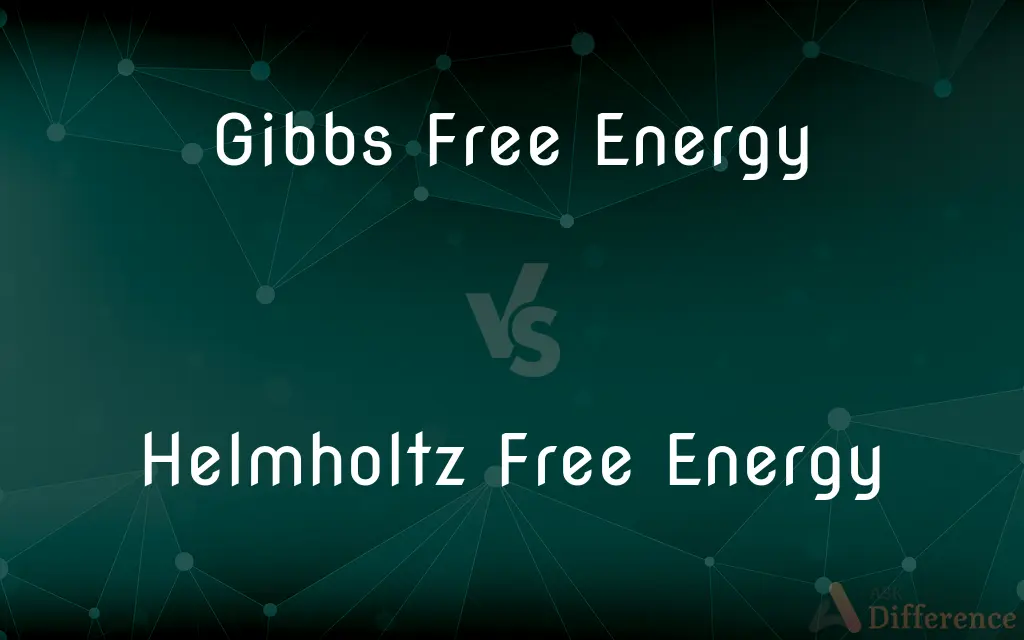Gibbs Free Energy vs. Helmholtz Free Energy — What's the Difference?
By Tayyaba Rehman — Published on December 24, 2023
Gibbs Free Energy (G) relates to energy in reactions at constant temperature and pressure. Helmholtz Free Energy (A) involves energy at constant temperature and volume. Both predict spontaneous processes.

Difference Between Gibbs Free Energy and Helmholtz Free Energy
Table of Contents
ADVERTISEMENT
Key Differences
Gibbs Free Energy, often denoted as G, is a thermodynamic potential that measures the "usefulness" or process-initiating work obtainable from a system at a constant temperature and pressure. Conversely, Helmholtz Free Energy, symbolized by A, represents the maximum work that a system can perform at a constant temperature and volume, excluding the work of volume expansion.
Gibbs Free Energy considers both enthalpy (H) and entropy (S) changes in a system. It's defined as
�
=
−
ADVERTISEMENT
G=H−TS. The change in Gibbs Free Energy, ΔG, predicts the spontaneity of a reaction at constant pressure. On the other hand, Helmholtz Free Energy, which is
A=U−TS (with U being the internal energy), focuses on the energy changes at constant volume.
When analyzing chemical reactions, Gibbs Free Energy is of paramount importance, especially in systems like biological organisms that mostly operate at constant atmospheric pressure. Helmholtz Free Energy is more applicable in scenarios where volume remains unchanged, which are less common in practical chemistry.
In essence, both Gibbs Free Energy and Helmholtz Free Energy serve as criteria for spontaneous reactions under different conditions. However, their differentiating factor lies in their applications: Gibbs for constant pressure processes and Helmholtz for constant volume processes.
One might deduce that while both concepts relate to the spontaneity of processes and the maximum work obtainable, Gibbs Free Energy and Helmholtz Free Energy diverge in their practical applications due to the distinct conditions they address.
Comparison Chart
Definition
Energy at constant temperature and pressure.
Energy at constant temperature and volume.
Formula
G=H−TS
A=U−TS
Predicts spontaneity at
Constant pressure.
Constant volume.
Commonly used in
Biological systems and chemical reactions at atmospheric pressure.
Systems where volume remains unchanged.
Measures
Maximum non-expansion work.
Maximum work excluding volume expansion.
Compare with Definitions
Gibbs Free Energy
Reflects the maximum usable energy from a system.
Energy conversions in cells involve Gibbs Free Energy changes.
Helmholtz Free Energy
Thermodynamic potential at constant temperature and volume.
Helmholtz Free Energy helps predict behavior in sealed systems.
Gibbs Free Energy
Represents non-expansion work in a system.
In electrochemical cells, the flow of electrons is driven by Gibbs Free Energy changes.
Helmholtz Free Energy
Criteria for reaction spontaneity at constant volume.
At constant volume, a decrease in Helmholtz Free Energy indicates spontaneity.
Gibbs Free Energy
Thermodynamic potential at constant temperature and pressure.
A negative ΔG indicates a spontaneous reaction under constant pressure.
Helmholtz Free Energy
Reflects energy excluding volume expansion work.
In systems without volume change, Helmholtz Free Energy governs process spontaneity.
Gibbs Free Energy
Criteria for reaction spontaneity at constant pressure.
For a reaction to be spontaneous at constant temperature and pressure, Gibbs Free Energy should decrease.
Helmholtz Free Energy
Represents energy changes in constant volume systems.
Some specialized reactions are evaluated using Helmholtz Free Energy changes.
Gibbs Free Energy
Combines enthalpy and entropy to predict reactions.
Gibbs Free Energy ensures both heat and disorder factors are considered for reactions.
Helmholtz Free Energy
Involves internal energy and entropy.
Helmholtz Free Energy is crucial in thermodynamic studies where volume remains fixed.
Common Curiosities
Can Gibbs Free Energy predict spontaneity?
Yes, a negative ΔG predicts a spontaneous process at constant temperature and pressure.
What factors affect Gibbs Free Energy?
Enthalpy and entropy changes influence Gibbs Free Energy.
How is Helmholtz Free Energy different?
Helmholtz Free Energy assesses energy at constant temperature and volume, excluding volume expansion work.
Which energy is more relevant for biological systems?
Gibbs Free Energy, as most biological processes occur at roughly constant atmospheric pressure.
What is Gibbs Free Energy?
Gibbs Free Energy measures the maximum usable energy from a system at constant temperature and pressure.
When is Helmholtz Free Energy used?
It's used for systems where the volume remains unchanged.
Why is volume constant for Helmholtz Free Energy?
It's defined for scenarios without volume changes to analyze maximum non-expansion work.
In which scenario is Helmholtz more applicable than Gibbs?
In closed, sealed systems where volume remains unchanged.
Can ΔG be positive for a spontaneous process?
Generally, no. A negative ΔG usually indicates a spontaneous process at constant pressure.
Does Gibbs Free Energy involve temperature?
Yes, it considers energy at a constant temperature and pressure.
Do both energies help in determining spontaneity?
Yes, but under different conditions: Gibbs for constant pressure, Helmholtz for constant volume.
Is Helmholtz Free Energy often used in chemistry?
Less commonly than Gibbs, but it's vital for constant volume thermodynamic studies.
How does entropy factor into Helmholtz Free Energy?
It's part of its definition: A=U−TS, where S is entropy.
Are both energies state functions?
Yes, both Gibbs Free Energy and Helmholtz Free Energy are state functions.
Which energy combines both heat and disorder factors?
Both do, but Gibbs Free Energy is more commonly associated with this combination in practical applications.
Share Your Discovery

Previous Comparison
Normal Loss vs. Abnormal Loss
Next Comparison
Damped Oscillations vs. Undamped OscillationsAuthor Spotlight
Written by
Tayyaba RehmanTayyaba Rehman is a distinguished writer, currently serving as a primary contributor to askdifference.com. As a researcher in semantics and etymology, Tayyaba's passion for the complexity of languages and their distinctions has found a perfect home on the platform. Tayyaba delves into the intricacies of language, distinguishing between commonly confused words and phrases, thereby providing clarity for readers worldwide.
















































